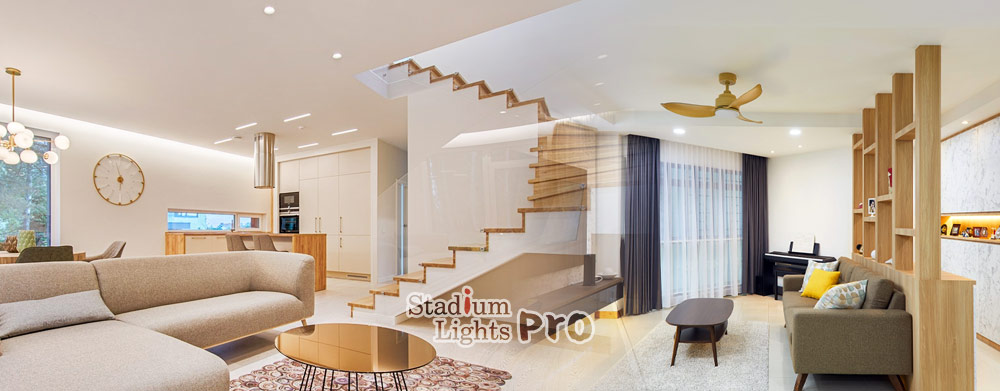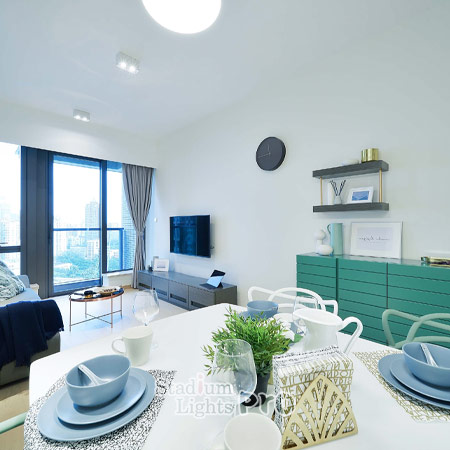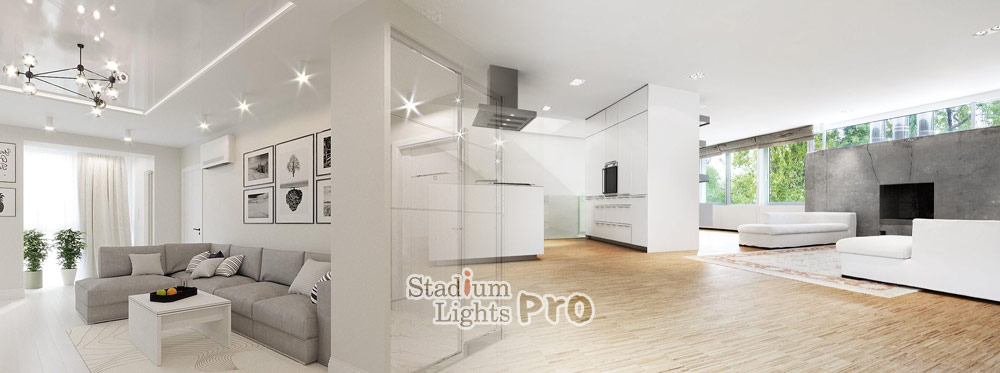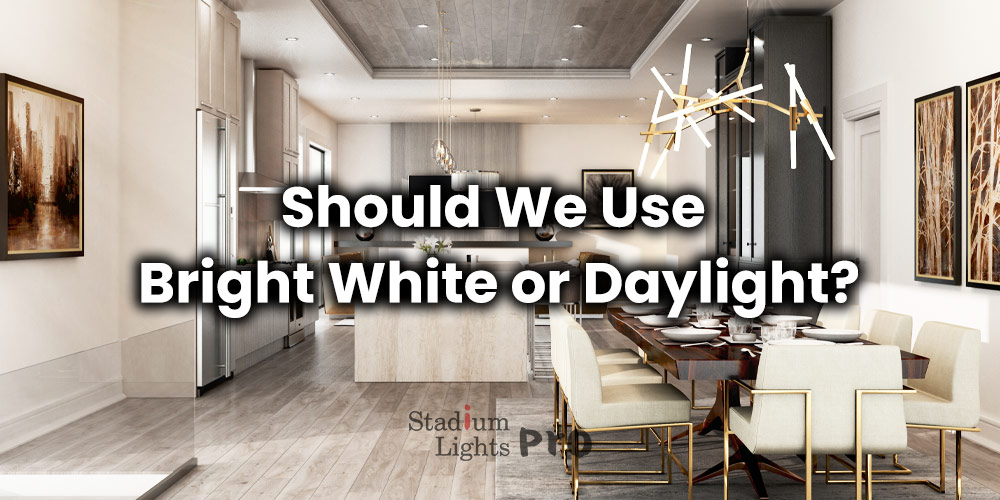Lighting plays a crucial role in creating the ambiance and atmosphere of a room. It can affect the mood, perception of space, and overall aesthetic of a room.
There is a debate among interior designers and homeowners on whether to use bright white or daylight lighting. Bright white lighting is known for its crisp, modern look, while daylight lighting is preferred for its natural, warm ambiance.
Table of Contents
ToggleBright white lighting

Bright white lighting refers to a type of artificial lighting that emits a cool and intense light, similar to natural daylight. It is characterized by its high color rendering index (CRI), which measures how well a light source reproduces colors. Bright white lights typically have a CRI of 85 or higher, making them ideal for showcasing the true colors of objects and surfaces in a room.
Bright white lighting is often used in commercial and modern settings such as retail stores, offices, and galleries. It is also popular in kitchen and bathroom spaces as it enhances the overall brightness and visibility. It is available in different forms of lighting like LED, fluorescent, incandescent, and halogen.
Some of the characteristic features of Bright white light are,
- High CRI, which means that it reproduces colors accurately and vividly
A cool and intense light that mimics natural daylight - Often used in commercial and modern settings
- Enhances visibility and brightness in specific spaces like kitchen and bathroom.
Bright white lighting can also be used to create a sleek and modern look in a room, making it a popular choice among homeowners who prefer a contemporary aesthetic.
Advantages of using bright white lights
Enhances color and detail in a room
 Bright white lighting has a high color rendering index (CRI), which means it reproduces colors accurately and vividly. This can make a room appear more vibrant and colorful, and can also help to showcase the true colors of artwork, fabrics, and other decorative elements.
Bright white lighting has a high color rendering index (CRI), which means it reproduces colors accurately and vividly. This can make a room appear more vibrant and colorful, and can also help to showcase the true colors of artwork, fabrics, and other decorative elements.
Creates a modern and sleek look
It can be used to create a contemporary and minimalist aesthetic in a room. It can help to make spaces appear more open and airy, and can also be used to highlight architectural features and design elements.
Can make a room appear larger
We can use bright white light to create the illusion of more space in a room. It can help to brighten up dark corners and make low-ceilinged rooms appear taller. It is also a good option for small spaces, as it can make them feel more open and expansive.
Energy-efficient
They are often LED or CFL which are energy-efficient, they consume less power and last longer. This can help to reduce energy costs and also reduce the frequency of replacing light bulbs.
Can be used for task lighting
Bright white lights are good for task lighting as it provides a clear and bright light that is suitable for reading, working, or other activities that require good visibility.
Cost-effective
Bright white lights are often less expensive than other types of lighting, and can provide a similar level of illumination for less cost.
Disadvantages of using bright white lights
Can be harsh and uncomfortable to the eyes
Bright white lighting can be intense and overwhelming when used in large spaces or for long periods of time. It can cause eye strain, headaches, and fatigue, and can also make a room feel uninviting and uncomfortable.
Can make a room appear sterile and uninviting
They can create a stark and clinical atmosphere, which can be unappealing in residential settings. It can also make a room appear cold and uninviting, which can be detrimental to the overall ambiance and mood of a space.
Can be difficult to match with other colors
It can be difficult to match with other colors in a room. It can wash out other hues and make them appear dull and faded. This can be especially problematic when trying to coordinate with warm or bold colors.
Can be costly to install and maintain
They may require special fixtures, dimmer switches, or other equipment to control and distribute the light. This can be costly and may require professional installation, which can add to the overall expense of using bright white lighting in interior design.
Can be harsh on certain surfaces
Bright white lights can be too intense for certain surfaces, such as delicate fabrics or paintings. It can cause fading, discoloration, or other damage over time. This must be considered while planning the lighting in spaces like art galleries, museums or libraries.
Daylight lighting

Daylight lighting refers to lighting that mimics the natural light of the sun. It is characterized by its warm and soft tones, and its ability to change throughout the day, just like natural daylight. It typically has a color temperature of around 5000K-6500K, which is similar to the natural light of a clear, sunny day.
It is primarily used in residential settings such as living rooms, bedrooms and kitchens to create a natural and warm ambiance. Moreover, it can also be used in outdoor spaces like patios, decks and gardens to enhance the natural beauty of the surroundings. This type of lighting is available in various forms including skylights, windows, and specially designed light fixtures.
Some of the characteristic features of daylight lighting are:
- Warm and soft tones that mimic natural light
- Ability to change throughout the day
- Typically has a color temperature of around 5000K-6500K
- Often used in residential settings to create a natural and warm ambiance
- Can be used in outdoor settings to enhance the natural beauty of the surrounding environment
They can be beneficial for creating a healthy and comfortable living environment. It can help to improve mood and overall well-being, and can also help to reduce the need for artificial lighting during the day.
Advantages of using daylight
Provides a natural and warm ambiance
Daylight lighting mimics the natural light of the sun and creates a warm and inviting atmosphere in a room. It can help to improve the overall mood and well-being of those in the space.
Can reduce the need for artificial lighting
During the day, daylight lighting can provide ample illumination, reducing the need for artificial lighting. This can help to save energy costs and also reduce the strain on the eyes.
Can improve mood and overall well-being
It can help to improve mood and overall well-being by providing a natural and healthy light source. It can help to reduce stress, improve concentration and boost energy levels.
Enhances natural beauty of the surroundings
Daylight can enhance the natural beauty of outdoor spaces like gardens, patios and decks. It can also be used to highlight architectural features and design elements of the surrounding environment.
Cost-effective
In comparison to other forms of lighting, daylight can be cost-effective. For example, a skylight or a window can provide natural light without the need for extra light fixtures.
Health benefits
Daylight can also help to regulate circadian rhythms, improve sleep, and reduce the risk of certain health conditions such as seasonal affective disorder.
Disadvantages of using daylight
Can be difficult to control and inconsistent
Daylight can be affected by weather conditions and the time of day, which can make it difficult to control and predict. This can be a disadvantage for spaces that require consistent lighting for certain activities or tasks.
Can cause glare and reflection problems
Daylight lighting can cause glare and reflection problems, especially when it is directed towards glossy surfaces or electronic screens. This can be a problem in spaces such as offices or media rooms.
Can cause fading and discoloration
It can cause fading and discoloration over time, when it is directed towards delicate fabrics, artwork, or other sensitive materials. This can be a problem in spaces such as art galleries or museums.
Can be costly to install and maintain
Daylight lights can be costly to install and maintain, when it involves the installation of skylights or other specialized fixtures.
Privacy issues
The use of natural light in the form of windows or skylights can be a potential privacy concern, especially for living spaces that face public or busy areas.
Dependent on weather
In spaces where natural daylight is the main source of light, it may not be possible to light the space during bad weather or night time. This could be a problem for spaces that need to be lit consistently.
The difference between bright white and daylight
This table provides a summary of the differences between bright white and daylight lighting. It can be used as a reference when deciding which lighting option is best for your interior design needs.
| Bright white | Daylight |
| High CRI, reproduces colors accurately and vividly | Warm and soft tones that mimic natural light |
| A cool and intense light that mimics natural daylight | Ability to change throughout the day |
| Often used in commercial and modern settings | Often used in residential settings to create a natural and warm ambiance |
| Enhances visibility and brightness in specific spaces like kitchen and bathroom | Can be used in outdoor settings to enhance the natural beauty of the surrounding environment |
| Creates a modern and sleek look | Can improve mood and overall well-being |
| Can make a room appear larger | Can reduce the need for artificial lighting |
| Energy-efficient | Enhances natural beauty of the surroundings |
| Can be used for task lighting | Cost-effective |
| Can be harsh and uncomfortable to the eyes | Health benefits |
| Can make a room appear sterile and uninviting | Can be difficult to control and inconsistent |
| Can be costly to install and maintain | Glare and reflection problems |
| Can be harsh on certain surfaces |
Bright white vs daylight frequently asked questions
Is daylight or bright white light brighter?
Bright white lighting is generally considered to be brighter than daylight lighting. This is because bright white lighting has a higher color rendering index (CRI) which means that it reproduces colors accurately and vividly. Bright white lights are also known for their cool and intense light that mimics natural daylight. They emit a cool and intense light that can be used to enhance visibility and brightness in specific spaces like kitchen and bathroom. On the other hand, daylight lighting is known for its warm and soft tones that mimic natural light, the light changes throughout the day and it is often used in residential settings to create a natural and warm ambiance.
What color is most similar to natural light?
The color closest to natural light is a cool white or daylight color temperature around 5000K-6500K. This color temperature is similar to the color of natural light on a clear, sunny day. It is also known as “daylight white” or “cool daylight”, and it is often used in residential and commercial settings to mimic the natural light of the sun. This color temperature is considered to be a neutral white light, with a slight blue or green tint that is closest to natural light. It is also considered to be a good color for task lighting as it provides a clear and bright light that is suitable for reading, working, or other activities that require good visibility.
What is the difference between bright white and daylight bulbs?
Bright white bulbs have a color temperature of around 3500-4100K, while daylight bulbs have a color temperature of around 5000-6500K. This means that daylight bulbs will appear cooler and more blue-toned, while bright white bulbs will appear warmer and more yellow-toned.
Which is better for a specific room or task?
This depends on personal preference and the intended use of the room or task. Daylight bulbs are often used in kitchens, bathrooms, and other task-oriented spaces because they provide a brighter, more natural light. Bright white bulbs are often used in living spaces, bedrooms, and other areas where a warm, cozy atmosphere is desired.
Are bright white or daylight bulbs more energy efficient?
The energy efficiency of a bulb is determined by its wattage, not its color temperature. So, two bulbs with the same wattage will have the same energy efficiency regardless of whether they are bright white or daylight.
Can bright white or daylight bulbs be used with dimmer switches?
Not all bulbs are compatible with dimmer switches, so it’s necessary to check the manufacturer’s specifications before purchasing a bulb for use with a dimmer switch. If a bulb is not specifically designed for use with a dimmer switch, it may flicker or not work properly when dimmed.
Are bright white or daylight bulbs better for reading?
This depends on personal preference and the environment in which the reading is taking place. Daylight bulbs provide a brighter, more natural light that can be easier on the eyes for reading. However, if you prefer a warmer, softer light for reading, a bright white bulb may be more suitable.
Are bright white or daylight bulbs better for home security?
Daylight bulbs can provide a brighter, more natural light that can help deter intruders. They can also make it easier for neighbors and passersby to see any suspicious activity around your home. Bright white bulbs, on the other hand, can create a warm and inviting atmosphere that may not be as effective for security purposes.
Do bright white or daylight bulbs last longer?
The lifespan of a bulb is determined by the number of hours it is rated to last, not its color temperature. So, two bulbs with the same rated lifespan will last the same amount of time regardless of whether they are bright white or daylight.
Are bright white or daylight bulbs more expensive?
The cost of a bulb is determined by its type, wattage, and features, not its color temperature. So, the price of a bright white bulb and a daylight bulb of the same type, wattage and features will be the same.
Can bright white or daylight bulbs be used in outdoor lighting?
Both bright white and daylight bulbs can be used in outdoor lighting, depending on the specific application. Daylight bulbs may be more suitable for areas such as security lighting, while bright white bulbs may be more suitable for areas such as porch or patio lighting, where a warm and inviting atmosphere is desired. We can check the manufacturer’s specifications for weather resistance and to use appropriate fixtures for outdoor use.
Are there any health concerns associated with using bright white or daylight bulbs?
Prolonged exposure to bright light, including the blue light emitted by daylight bulbs, can disrupt the body’s natural sleep-wake cycle and contribute to insomnia, fatigue, and other sleep-related issues. It’s recommended to use lower-intensity lighting in the evening and during bedtime to help promote healthy sleep patterns.
Conclusion
Bright white lighting and daylight lighting are two popular options, each with their own advantages and disadvantages. Bright white lighting is known for its crisp, modern look, while daylight lighting is preferred for its natural, warm ambiance.

